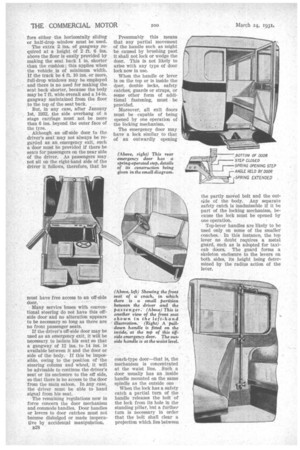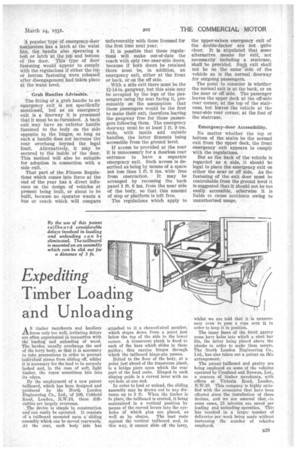EMERGENCY EXITS
Page 45

Page 46

Page 47

If you've noticed an error in this article please click here to report it so we can fix it.
which conform with thee law
NDER the Public Service
UVehicles (Conditions of Fitness) Regulations, 1931, certain stipulations, some of which are now' in force, whilst others do not apply until January 1st, 1932, are made with regard to emergency exits.
The regulations, whether now in force or to become operative at the end of the year, embrace chiefly Such details as have already been
(Right) The various parts of a door handle with a safety catch. The top drawing shows the handle with the outer part turned over at A; this helps to exclude water from the spring. The middle view, in part section, depicts the spring which keeps the ball catch (C) in position. The bottom illustration shows the fixed collar (B), which has a depression (D) to receive the ball (E) of the yoke
anticipated by many builders and operators. Nevertheless, it is evident that closer attention will have to be paid to more convenient access to the emergency exit than has hitherto obtained. Moreover, difficulties are likely to arise as to the exact interpretation of any particular regulation.
At the present time the emergency exit must not be obstructed by a seat of any kind. Occasionally, when the emergency exit has been at the rear, it has been the practice to place a flap or lift-up seat in the
middle of a cross-wise seat, making a complete row extending for the full width of the body. In other instances the end of a seat adjacent to a near-side exit has been made to fold, or the whole seat has been designed to tip up. These designs of seat must be abandoned. and the gangway to the exit always maintained.
The gangway is defined as being not less than 12 ins, up to a height
a recessed door. Directly above is a plan view of the exit illustrated in the drawing be side U. The front two rows of seats accommodate altogether six persons, there being ample free space around
the door, which opens outwards.
of 2 ft. 6 ins, from the floor level, and above that height the gangway /must not be less than 14 ins. wide.
When there are double crosswise seats on each side of the central gangway the vehicle must be at least 6 ft. 4 ins. wide inside. That is, twice 2 . ft. 8 ins, for the seats, plus the 12-in, gangway. If the track be of minimum dimensions, say 4 ft. 8 ins., then the overall width must not exceed 6 ft. 9 ins., which represents an allowance of 2i ins, for the thickness of each side of the body.
This is barely sufficient for window casings below the waist, thereB27 fore either the horizontally sliding or half-drop window must be used.
The extra 2ins, of gangway required at a height of 2 ft. 6 ins. above the floor is easily provided by making the seat back 1 in. shorter than the cushion ; this applies when the vehicle is of minimum width. If the track be 4 ft. 10 ins, or more. full-drop windows may be employed and there is no need for making the seat back shorter, because the body may be 7 ft. wide overall and a 14-in. gangway maintained from the floor to the top of the seat back.
But, in any case, after January 1st, 1932, the side overhang of a stage carriage must not be more than 6 ins, beyond the outer face of the tyre.
Although an off-side door to the driver's seat may hot always be regarded as an emergency exit, such a door must be provided if there be seats for passengers on the near side of the driver. As passengers may not sit on the right-hand side of the driver it follows, therefore, that he must have free access to an off-side door, • Many service buses with conventional steering do not have this offside door and no alteration appears to be necessary so long as there are no front passenger seats.
• If the driver's off-side door may be used as an emergency exit, it will be necessary. to isolate his seat so that a gangway of 12 ins. to 14 ins, is available between it and the door or side of the body. If this be impossible, owing to the position of the steering column and wheel, it will be advisable to continue the driver's seat or its enclosure to the off side, so that there is no access to the door from the main saloon. In any case, the driver must be able to hand signal from his seat.
The remaining regulations now in force concern the door mechanism and commode handles. Door handles or levers to door catches must not become dislodged or made inoperative by accidental manipulation. B28
Presumably this means that any partial movement of the handle such as might be caused by brushing past it shall not lock or wedge the door. This is not likely to arise with any type of door lock now in use.
When the handle or lever Is on the top or is inside the door, double locks, safety catches, guards or straps, or some other form of additional fastening, must be provided.
Moreover, all exit doors must be capable of being opened by one operation of the locking mechanism.
The emergency door may have a lock similar to that of an outwardly opening (Above, left) Showing the front seat of a coach, in which there is a small partition between the driver and the passenger. (Above) This is another view of the front seat shown in the left.hand illustration. (Right) A pull. down handle is fitted on the inside, at the top of this tiffside emergency door. The out. side handle is at the waist level.
coach-type door—that is, the mechanism is concentrated at the waist line. Such a door usually has an inside handle mounted on the same spindle as the outside one When the lock has a safety catch a partial turn of the handle releases the bolt of the lock from its hole in the standing pillar, but a further turn is necessary in order that the bolt shall clear a projection which lies between the partly moved bolt and the outside of the body. Any separate safety catch is inadmissible if it be part of the locking mechanism, because the lock must be opened by one operation.
Top-lever handles are likely to be used only on some of the smaller coaches. In this instance, the top lever no doubt requires a metal guard, such as is adopted for taxicab doors. The guard forms a skeleton enclosure to the levers on both sides, its height being determined by the radius action of the lever. popular-type-of emergency-door mechanism has a latch at the waist line, the handle also operating a belt or latch at tbe top and bottom of the door. This type of door fastening would appear to comply with the regulations if either the top or bottom fastening were released after disengagement had taken place at the waist level.
Grab Handles Advisable.
The fitting of a grab handle to an emergency exit is not specifically mentioned, but as an emergency exit is a -doorway it is presumed that it must be so furnished. A back exit may have an exterior handle fastened to the body on the side opposite to the hinges, so long a$ such a handle does not increase the rear overhang lbeyond the legal limit. Alternatively, it may be secured to .the; inside of the 'door. This method will also be suitable for adoption in connection with a side exit.
That part of the Fitness Regulations which comes into force at the end of the year has a direct influence on the design of vehicles at present being built, or about to be built, because no operator wants a bus or coach which will compare
unfavourably with those licensed for the first time next year.
It is possible that these regulations will make out-of-date the coach with only two near-side doors, because if both doors beretained there must be, in addition, an emergency exit, either at the front or hack, or on the off side.
With a side exit there must be the 12-14-in, gangway, but this aisle may be occupied by the legs of the passengers using the seat facing it, presumably on the assumption that these passengers would be the first to make their exit, therefore leaving the gangway free for those passengers following them. The emergency doorway must be at least 1 ft. 9 ins. wide, with inside and outside handles, the latter fitments being accessible from the ground level.
If access be provided at the rear it is unnecessary for a doorless rear entrance to have a separate emergency exit. Such access is described as being by means of a space not less than 1 ft. 6 ins, wide free from obstruction. It may be arranged by recessing the back panel 1 ft. 6 ins from the near side of the body, so that this amount of step or platform is left free.
The regulations which apply to
the upper-saloon emergency exit of the double-decker are not quite clear. It is stipulated that some alternative means for exit, not necessarily including a staircase, shall be provided. Suet exit shall not be on the same—side of the vehicle as is the normal doorway for outgoing passengers.
The point to consider is whether the normal exit is at the back, or on the near or off side. The passenger leaves the upper deck at the off-side rear corner, at the top of the staircase, but leaves the vehicle at the near-side rear corner, at the foot of the staircase, Emergency-door Accessibility.
No matter whether the top or bottom of the stairs be the normal exit from the upper deck, the front emergency exit appears to comply with the regulations.
But as the back of the vehicle is regarded as a side, it should be legal to place the emergency exit on either the near or off side. As the fastening of the exit door must be controllable from the ground level it is suggested that it should not be too easily accessible, otherwise it is liable to cause accidents owing to unauthorized usage.




































































































